Watch: The scene at St John's, Newfoundlandpublished at 11:10 BST 21 June 2023
The BBC's Nadine Yousif is in Newfoundland - where the expedition to the Titanic wreck began.
Titanic sub: St John's hoping for safe return
Canada's Transportation Safety Board says it is launching an investigation after the implosion of the Titan submersible left all five passengers dead
In the US, a separate probe will be launched involving the American counterpart and US Coast Guard
Tributes have been paid to Hamish Harding who would have turned 59 on Saturday, Shahzada Dawood, 48, and his son Suleman Dawood, 19, Paul-Henri Nargeolet, 77, and Stockton Rush, 61
Emails seen by the BBC show that concerns from an expert over the safety of the Titan sub were dismissed by OceanGate CEO Rush in 2018
Other industry experts have also raised questioned following the "catastrophic implosion"
But an OceanGate investor who has made the trip down to the Titanic told the BBC that the idea Rush had done anything wrong was "disingenuous"
It's emerged the US Navy originally detected “an acoustic anomaly consistent with an implosion” shortly after the Titan lost contact on Sunday
Brandon Livesay & Alex Binley
The BBC's Nadine Yousif is in Newfoundland - where the expedition to the Titanic wreck began.
Titanic sub: St John's hoping for safe return
 Victoria Gill
Victoria Gill
Science correspondent
A submarine search and rescue expert in Australia, Frank Owen, tells the BBC his “confidence went up by an order of magnitude” when he heard reports of banging being detected by floating sound detectors.
“There's a couple of reasons for that,” he explains. “Firstly, on board this craft is a retired French navy diver. He would know the protocol for trying to alert searching forces… on the hour and the half hour you bang like hell for three minutes.”
He says the sound signal being picked by a buoy close to the surface also suggests that the sub itself could be near or at the surface.
“Below about 180 metres, the water temperature drops very rapidly,” he explained. “That creates a layer that the [sonar signal] bounces off. But if you’re in the same depth water it tends to go quite straight.”
Even if Titan is at the surface, it will be difficult to spot. Very little of the small, white vessel sits above the water.
But using an array of sound-detecting buoys to triangulate the signal could narrow down its position.
More now from Simon Boxall, senior lecturer in oceanography at the University of Southampton, who was on the World Service's Newsday programme earlier.
"The pressure there [the Titanic wreck is 3,800m underwater] is phenomenal," Boxall says.
"It would crush anyone who tried to get out of it. If you tried to escape at that depth, you'd last less than a second."
Because of this, the sub needs to be brought to the surface, he says.
 Jonathan Amos
Jonathan Amos
Science correspondent
Sound is the way you communicate in the ocean. Whales and porpoises use it, and so do humans.
All forms of electromagnetic radiation, for example, radio and radar, are pretty useless.
But sound travels efficiently, it travels fast (1,500m/s) and over great distances.
This is why the rescue operation has been dropping sonobuoys in the water, listening for any sounds that are out of the ordinary.
If these reported bangings are real – and the authorities certainly consider them worth investigating – they can use them to locate the sub.
If they’re transmitted as a regular pattern, you can time the arrival of that pattern at different sonobouys to get a fix on the source.
The GPS receiver does something similar in your phone, using radio signals transmitted from different satellites.
The sound approach is nothing like as accurate, but would be a major help in narrowing down the unmanned remotely operated vehicle's efforts.
Simon Boxall is a Senior Lecturer in Oceanography at the University of Southampton and earlier told the BBC that the underwater noises give hope that those on board are still alive.
"There are plenty of sound sources in the ocean, but it does give hope," he told Newsday on the World Service.
"I think one of the scenarios that everyone feared was that the submersible had basically imploded. So it does give some hope that this is still a rescue operation, rather than just a recovery operation."
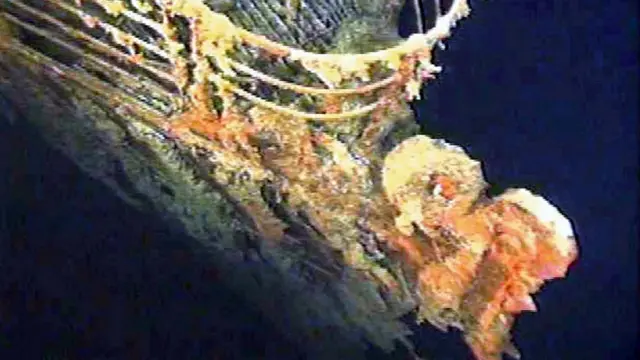 Image source, File photo
Image source, File photoDik Barton, the first British diver to see the Titanic wreck, says the site is a "dangerous" and "hostile" place to be.
"There's a local ebb and current of water which moves around, it's not consistent. The strength of the submersible is relatively limited," he told ITV's Good Morning Britain.
"The thrusters are quite strong but, at the end of the day, you have to conserve your power because it's your life support system and navigation system."
Sharing his thoughts on how the vessel could be found, Barton added it may have to be recovered back to the surface as there is no way of accessing the submersible on the sea bed.
The BBC's Carl Nasman explains what happened with the lost submersible vessel and what is being done to try to find it.
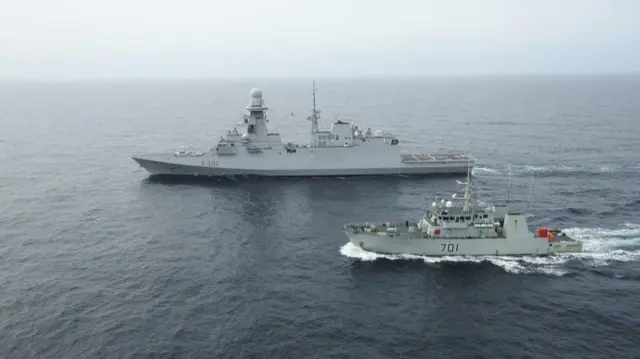 Image source, HMCS Glace Bay / Facebook
Image source, HMCS Glace Bay / FacebookMore help is on the way. The Royal Canadian Navy ship HMCS Glace Bay is expected to arrive at the scene of the search on Thursday at midday local time.
Onboard the ship is a medical team specialising in dive medicine, and a six-person mobile hyperbaric recompression chamber.
If the sub is located, the recompression chambers on board this ship can be used to treat or prevent decompression sickness. When divers are exposed to rapid decreases in pressure, nitrogen forms bubbles in tissue and blood.
A Canadian Coast Guard Ship, the Terry Fox, is already at the scene, on standby to load search and rescue equipment and personnel.

Terry Virts (right) with his friend Hamish Harding, who is one of the passengers on board the Titan
Colonel Terry Virts, who is a former commander of the International Space Station and a friend of Hamish Harding, has been speaking to the BBC and says the rescue mission is a race against time.
"I believe that if they can be rescued they will be just because of the amount of effort that's being put in," he tells Newsday.
"But they're in a tough situation and the clock is ticking. According to the company specs and the submarine spec, on Thursday they will probably be out of oxygen.
Quote Message"So either we get them up in the next day or two or it's not looking good. The clock is definitely ticking."
 Jonathan Amos
Jonathan Amos
Science correspondent
On a positive note, we should remember that one of the crew of the Titan submersible has immense naval experience.
Paul-Henry Nargeolet, who’s one of the world’s foremost Titanic experts, spent 25 years in the French Navy.
He will know the protocols to follow to give the rescue operation at the surface the greatest chance of finding the lost vehicle.
Has Nargeolet instigated some routine of banging to attract the attention of the sonar surveys?
It’s all speculation at the moment, but every potential lead must be followed up at pace with the life support system onboard reckoned to have only a day’s breathable air left.
 Jonathan Amos
Jonathan Amos
Science correspondent
Deep-sea experts we've spoken to say it’s hard to determine what these noises might be without seeing the data.
But it’s possible they could be short, sharp, relatively high frequency noises made by hitting the titanium end bell with another piece of metal or hard object within the pressure vessel.
This ought to be distinguishable from the general white noise of the ocean, especially if it has a regular pattern at timed intervals.
Certainly, it would seem the rescue operation is sufficiently convinced by the sounds to pursue them further, even moving their ROV (remotely operated vehicle) operations to a different location.
We've heard from the Explorers Club, who are offering to help locate the submersible using remotely operated vehicles (ROV) or underwater robots from the UK's Magellan company (see previous post).
The remote-operated vehicles can go as deep as 6,000 metres and have been to the wreckage of the Titanic before, Explorers Club president Richard Garriott has said.
Two of those on board the submersible, Hamish Harding and Paul-Henri Nargeolet, are members of the club, a global network for scientific exploration.
Garriott noted that there had been signs of life as the search entered crucial hours - banging sounds were earlier reported in the area where the submersible is believed to be located.
 Image source, Magellan Equipment and Resources
Image source, Magellan Equipment and ResourcesMagellan's remotely operated vehicle
Magellan, a British firm that specialises in deep ocean investigations and recovery operations, has said it is supporting the rescue mission for the Titan.
The company said in a statement on its website it had experience operating at even deeper depths.
Magellan said it was contacted by OceanGate early on Monday and "immediately offered our knowledge of the specific site and also our expertise operating at depth considerably in advance of what is required for this incident".
"We have been working full-time with UK and US agencies to secure the necessary air support to move our specialist equipment and support crew.
"We are ready to support, and we are fully mobilised to help," the firm said.
On the surface:
The sub might be able to alert rescuers if it can reach the surface through radio transmitters and GPS signals. It has strobe lights and radar reflectors to help the rescue teams spot them.
But locating the sub may be hard, especially from the air because it's white in colour. Changeable weather and poor visibility will also pose a challenge to the teams.
Underwater:
Rescuers must also comb depths that could reach nearly 4km (2.5 miles) to look for the craft, which is 6.7m (22ft) long. The US Coast Guard has extended the search into deeper waters.
Radio and GPS signals can't travel through water, so the only other way to detect the sub is through sonar and sonar bouys, often used in hunting for enemy submarines.
They work by detecting movements and sounds in the water - like the one the US Coast Guard reported - or by bouncing a sonar "ping" off the surface of the vessel (active detection) and listening for the returning echo.
Read more about how the teams are locating the sub here.
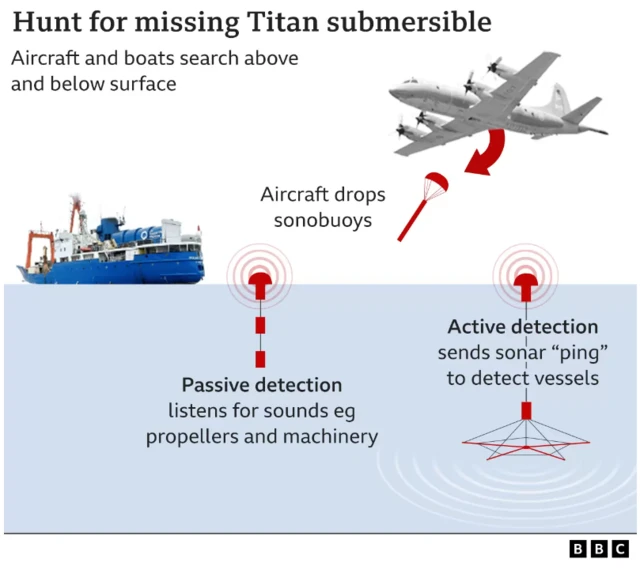
The BBC Verify team looks at all the ships in the area and who can help with the rescue.
Who is involved in search efforts
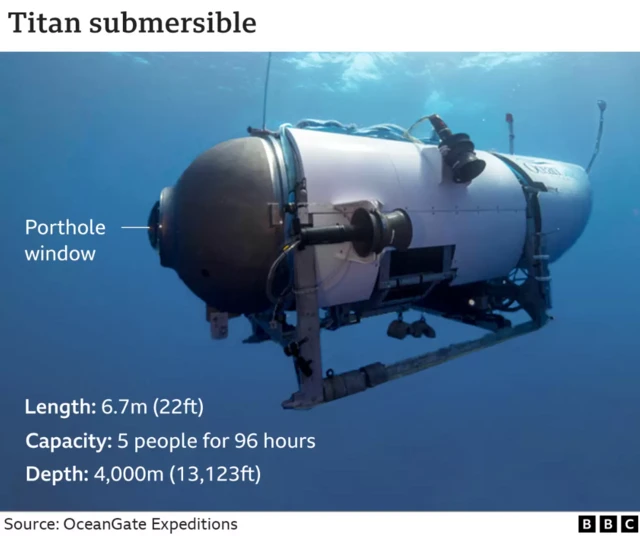
 Image source, OceanGate
Image source, OceanGateStockton Rush is a trained engineer and CEO of OceanGate
OceanGate's chief executive Stockton Rush is one of the five people in the submersible.
In 2017, he spoke to the BBC's Business Correspondent, Beth Timmins, about his business.
Rush said at that time that a trip to explore the Titanic for eight days would cost $105,129 (£82,000). It was the first time a journey that deep had been opened up to tourists.
Now, the expedition costs $250,000 per person to travel around 645km (400 miles) into the Atlantic to the wreckage site.
Rush said he had always wanted to be an astronaut, but after completing an aerospace degree and engineering work on the US fighter programme, he was told that his 20/25 eyesight wouldn’t allow him to be an air force pilot.
As a keen scuba diver, he decided to launch submersible trips to depths that were previously the remit of government submarines.
Among his previous OceanGate guests are Everest climbers, nautical archaeologists and filmmakers. He's also had travellers as old as 92 and and as young as 12 on his vessels.
 Image source, SETI Institute
Image source, SETI InstitutePakistani businessman Shahzada Dawood and his son Suleman are two of the five passengers on board the sub.
Their family in Pakistan told the BBC in a statement they are British citizens.
The family is one of Pakistan's richest. Dawood is a trustee at the SETI Institute - a organisation researching the origins and prevalence of life and intelligence in the universe.
He is also on an advisory board for the Prince's Trust international and has links to the British Asian Trust, organisations set up by the King as Prince of Wales, according to his profile on the SETI website.
The search and rescue effort under way in the North Atlantic to find the submersible has gone on for more than three days.
Alistair Greig, professor of marine engineering from University College London, explains why the search is so challenging.
Titanic sub: Why it's so hard to find
Here's a summary of the US-Canada led search efforts for the Titan so far:
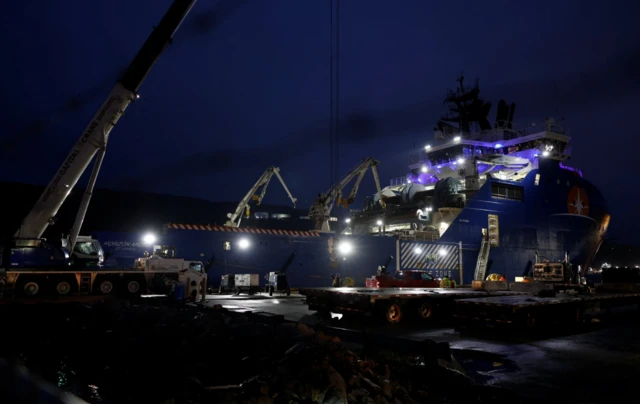 Image source, Reuters
Image source, ReutersAt a port in St John's, US Air Force equipment is loaded onto the Horizon Arctic, one of the vessels deployed to the search area